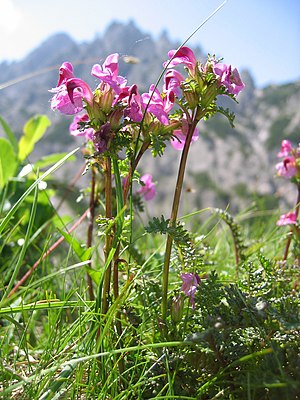Heady lice herb
| Heady lice herb | ||||||||||||
|---|---|---|---|---|---|---|---|---|---|---|---|---|

Head lice herb ( Pedicularis rostratocapitata ) in Upper Austria |
||||||||||||
| Systematics | ||||||||||||
|
||||||||||||
| Scientific name | ||||||||||||
| Pedicularis rostratocapitata | ||||||||||||
| Crantz |
The head louse herb ( Pedicularis rostratocapitata ), also called head lice herb or beaked louse herb , is a species of the genus lice herb ( Pedicularis ) within the family of the summer root plants (Orobanchaceae).
description
Vegetative characteristics
Heady louse herb grows as a perennial herbaceous plant and reaches heights of 5 to 20 centimeters. The stem has two rows of hairs ( indument ). The simple pinnate leaves are lanceolate with a length of 3 to 10 centimeters and have serrated leaflets.
Generative characteristics
The heady racemose inflorescence is not or barely longer than wide and contains 3 to 15 flowers. The bracts do not protrude from the calyx. The flowers are clearly (short) stalked.
The flowering period extends from June to August. The hermaphrodite flowers are zygomorphic with a double flower envelope . The calyx is 8 to 9 millimeters long and is usually ciliate and hairy on the longitudinal nerves, otherwise bald. The calyx-lobes, which are turned back at the tip, are about half as long as the calyx-tube. The mostly dark purple crown is 16 to 25 millimeters long and two-lipped. The upper lip bill is 3 to 5 millimeters long.
The number of chromosomes is 2n = 16.
ecology
In terms of flower ecology, the heady louse herb is a bumblebee flower .
Occurrence
The distribution area includes the Eastern Alps , Carpathians and the Northern Balkans . This limestone species prefers stony lawns at altitudes between 1200 and 2700 meters. In the Allgäu Alps, it comes from 800 meters in the valley up to an altitude of 2400 meters. It is a character species of the association Seslerion albicantis and occurs mainly in the Caricetum firmae and in the Seslerio-Caricetum sempervirentis.
In Austria this species is common in the alpine altitudes , it is absent in Vienna and Burgenland.
Systematics
Pedicularis rostratocapitata was first published in 1769 by Heinrich Johann Nepomuk von Crantz . Synonyms for Pedicularis rostratocapitata Crantz are: Pedicularis rostrata L. , Pedicularis jacquinii W.DJKoch .
From Pedicularis rostratocapitata there are about two subspecies:
- Pedicularis rostratocapitata Crantz subsp. rostratocapitata
- Pedicularis rostratocapitata subsp. glabra Kunz : It occurs in Italy.
literature
- Xaver Finkenzeller, Jürke Grau: Alpine flowers. Recognize and determine (= Steinbach's natural guide ). Mosaik, Munich 2002, ISBN 3-576-11482-3 .
- Manfred A. Fischer, Wolfgang Adler, Karl Oswald: Excursion flora for Austria, Liechtenstein and South Tyrol . 2nd, improved and enlarged edition. State of Upper Austria, Biology Center of the Upper Austrian State Museums, Linz 2005, ISBN 3-85474-140-5 .
Individual evidence
- ↑ a b c Erich Oberdorfer : Plant-sociological excursion flora for Germany and neighboring areas . With the collaboration of Angelika Schwabe and Theo Müller. 8th, heavily revised and expanded edition. Eugen Ulmer, Stuttgart (Hohenheim) 2001, ISBN 3-8001-3131-5 , pp. 860 .
- ↑ Erhard Dörr, Wolfgang Lippert : Flora of the Allgäu and its surroundings. Volume 2, IHW, Eching 2004, ISBN 3-930167-61-1 , p. 476.
- ↑ a b c Karol Marhold, 2011: Scrophulariaceae : Datasheet Pedicularis rostratocapitata In: Euro + Med Plantbase - the information resource for Euro-Mediterranean plant diversity.
Web links
- Pedicularis rostratocapitata Crantz, head lice herb. In: FloraWeb.de.
- Pedicularis rostratocapitata subsp. rostratocapitata Crantz, head lice herb. In: FloraWeb.de.
- Heady lice herb . In: BiolFlor, the database of biological-ecological characteristics of the flora of Germany.
- Profile and distribution map for Bavaria . In: Botanical Information Hub of Bavaria .
- Pedicularis rostratocapitata Crantz In: Info Flora , the national data and information center for Swiss flora . Retrieved March 19, 2016.
- Thomas Meyer: Lice herb data sheet with identification key and photos at Flora-de: Flora von Deutschland (old name of the website: Flowers in Swabia ).

